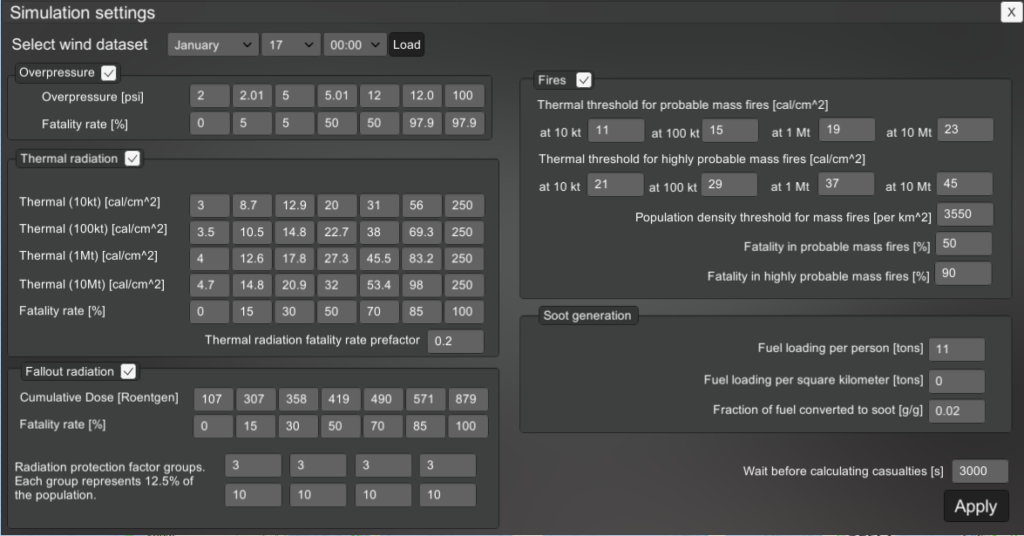How does this simulation work?
The NWS is built using Unity3D and is a stand-alone application which must be downloaded. Because of the large data-sets, the size of the software is about 3 GBs. The effects of nuclear weapons are calculated on the CPU using C# scripts for interaction with objects and on the GPU using compute shaders for interaction with the high-density population grid. Surface shaders are used to visualise data like population density, radiation dose from fallout and areas affected by fires.
Models used to calculate nuclear weapons effects
Overpressure is calculated using the Brode-Equation provided by Edward Geist https://github.com/GOFAI/glasstone.
Thermal radiation is calculated by digitizing the model in Samuel Glasstone and Philip J. Dolan “The effects of nuclear weapons”, Third Edition 1977.
Fallout is calculated using the WSEG10 model provided by Edward Geist https://github.com/GOFAI/glasstone
An alternative HYSPLIT-based model is available to calculate the total integrated fallout dose or the H+1 dose rate.
Prompt radiation is calculated using the data in Samuel Glasstone and Philip J. Dolan “The effects of nuclear weapons”, Third Edition 1977 and is converted from the repository by Edward Geist https://github.com/GOFAI/glasstone.
Height of burst at which fallout occurs is calculated using the equation from Samuel Glasstone and Philip J. Dolan “The effects of nuclear weapons”, Third Edition 1977.
Relative flash intensity and peak time are calculated from yield using the equations from Samuel Glasstone and Philip J. Dolan “The effects of nuclear weapons”, Third Edition 1977.
Conditions for mass fires are determined as a threshold of thermal radiation and population density with the Binninger model and values from “Nuclear war between Israel and Iran” by Dallas et al. 2013. Based on data from World War II, the fuel density threshold for mass fires is usually assumed to be 8 pounds fuel per square foot, which corresponds to a population density of 3550 /km^2 if we use the data in “Rapidly expanding nuclear arsenals in Pakistan and India portend regional and global catastrophe” by Brian Toon et al. Science Advances 02 Oct 2019.
Soot calculation is adapted from Brian Toon, Alan Robock and Rich Turco “Environmental consequences of nuclear war” 2008 and is limited to areas affected by probable fires. This model is work in progress and will be extended in the future. Extrapolation of the temperature curve from Toon et al, Physics Today 61, 12, 37 (2008) “Environmental consequences of nuclear war” is used to estimate the average global cooling.
Calculation of casualties
The effects mentioned above are calculated for each population density cell and adjustable fatality rate curves are used to calculate the casualties.

The fatality rate curves for overpressure, thermal radiation and cumulative fallout radiation dose are shown in the figure above. These curves can be adjusted if the user thinks they are too optimistic or too pessimistic.
The fatality rate curve for overpressure is adapted from “Casualty prediction comparisons” by D. I. Feinstein 1968.
The thermal radiation curves are digitized from John S. Duffield and Frank von Hippe ” The Short-term Consequences of Nuclear War for Civilians ” 1984. The curves are depending on the yield of the weapon because larger weapons have longer thermal pulse duration. The individual curves were adjusted using the probability for burns at different yields in Samuel Glasstone and Philip J. Dolan “The effects of nuclear weapons”, Third Edition 1977.
The fallout mortality rate curve is adapted from Joseph Rotblat ” Approximating the Probability of Mortality Due To Protracted Radiation Exposures ” 2016 (RIPD curve) assuming an LD50 of 639 cGy. The spectrum of protection factors is adapted from “Casualties Due to the Blast, Heat, and Radioactive Fallout from Various Hypothetical Nuclear Attacks on the United States” Daugherty et al. 1986.
Prompt radiation mortality rate curve is adapted from Joseph Rotblat “Acute Radiation Mortality in a Nuclear War” 1986.
Validation
Curves defined by the user can be validated by switching into a mode which will use the population density of Hiroshima from 1945 adapted from Web Table 1 of “Population Density in Hiroshima and Nagasaki Before the Bombings in 1945”, French et al American Journal of Epidemiology, Volume 187, Issue 8, August 2018.
Databases
Population density is imported from the GHSL Data Package 2019 https://ec.europa.eu/jrc/en/publication/ghsl-data-package-2019.
Pesaresi, Martino; Florczyk, Aneta; Schiavina, Marcello; Melchiorri, Michele; Maffenini, Luca (2019): GHS
settlement grid, updated and refined REGIO model 2014 in application to GHS-BUILT R2018A and GHS-POP
R2019A, multitemporal (1975-1990-2000-2015), R2019A. European Commission, Joint Research Centre (JRC)
[Dataset] doi:10.2905/42E8BE89-54FF-464E-BE7B-BF9E64DA5218 PID: http://data.europa.eu/89h/42e8be89-
54ff-464e-be7b-bf9e64da5218
CCMP vector winds are produced by Remote Sensing Systems and sponsored by NASA. Data are available at www.remss.com
